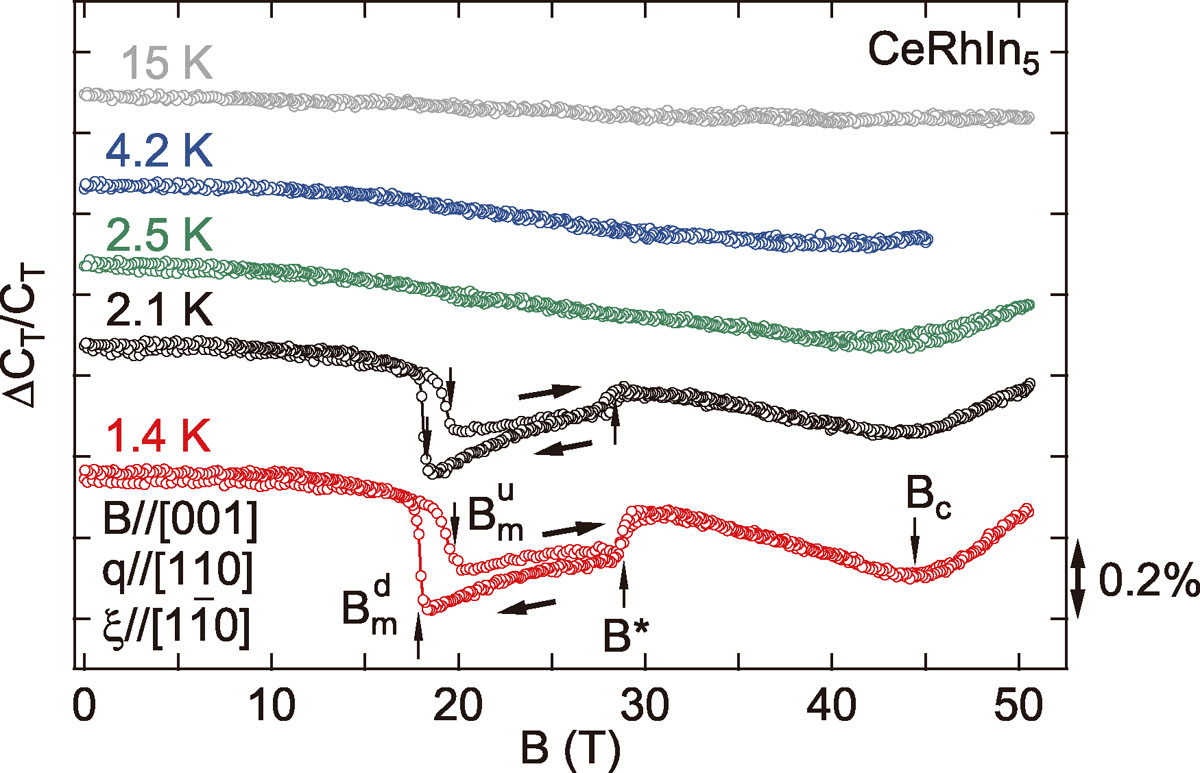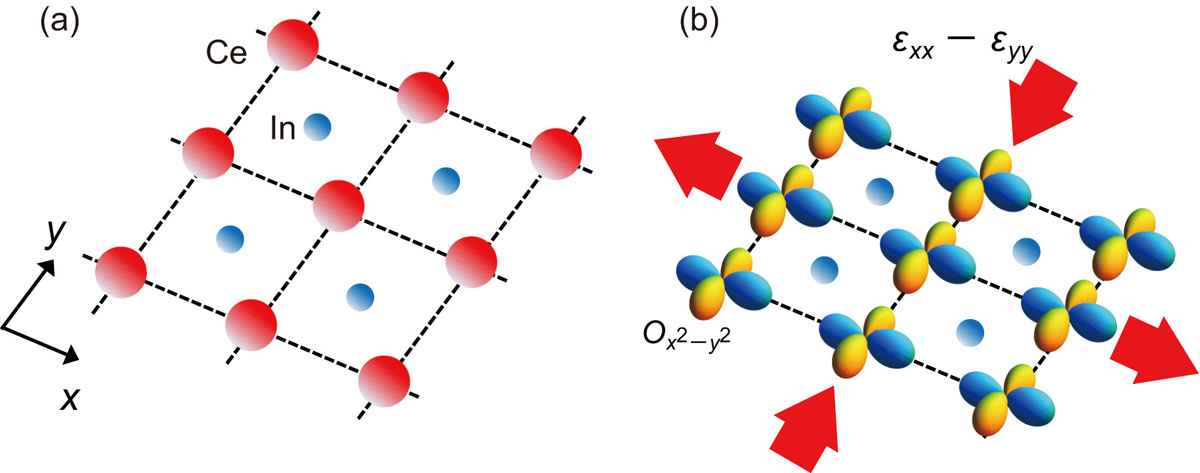High-Field Ultrasonic Study of Quadrupole Ordering and Crystal Symmetry Breaking in CeRhIn5
Tokunaga Group
In a number of strongly correlated electron systems, the electronic nematic (EN) state characterized by the lacking of the C4±-rotational operations has been focused because the EN contribution to superconductivity and other exotic phenomena have been proposed. Recently, the field-induced EN phase above 30 T has been proposed in the D4h1 tetragonal compound of CeRhIn5 [1,2], which was well known as a pressure-induced heavy-fermion superconductor.
To investigate the active representation and the order parameter of the field-induced EN phase, we performed an ultrasonic measurement for CeRhIn5 in pulsed magnetic fields up to 56 T [3]. The ultrasound technique is a powerful tool to determine the active representation of a phase transition related to the crystal symmetry breaking because sound waves can induce the symmetry strain belonging to the irreducible representation (IR) of the space group. Furthermore, we can propose the electric quadrupole as an order parameter of the crystal symmetry breaking and the EN state in terms of the electric quadrupole-strain interaction, which is based on the selection rule of group theory.
To identify the active representation of the symmetry breaking at the EN state, we measured all the elastic constants of CeRhIn5 that can be detected in the tetragonal system. As shown in Fig. 1, the transverse elastic constant CT = (C11 − C12)/2 with the B1g IR of D4h shows the anomaly at BIM = 28.5 T at 1.4 K and 2.1 K. This BIM is consistent with the previous studies [1, 2]. While CT shows an anomaly, other elastic constants, which can identify the symmetry breaking of B2g and Eg IR, do not exhibit anomaly at BIM. Therefore, our ultrasonic measurements demonstrate the B1g-type crystal symmetry breaking. Furthermore, the electronic degree of freedom with the B1g IR, namely the electric quadrupole Ox2 − y2 ∝ (x2 − y2)/r2, can be the order parameter of the EN state. This symmetry breaking is attributed by the electric quadrupole-strain coupling written as HQS = −gx2 − y2 Ox2 − y2 εx2 − y2.

Fig. 1. Magnetic field dependence of the transverse elastic constant ΔCT/CT at several temperatures for B//[001]. The vertical arrows indicate the metamagnetic transition field Bmu(d) for field up(down) sweep, the EN transition field B*, and the critical field Bc. The right and left arrows show hysteresis direction. The propagation direction q and polarization direction
We show the schematic view of the B1g-type ferroic electric quadrupole ordering and crystal symmetry breaking in Fig. 2. The square lattice of CeRhIn5 with the tetragonal crystal structure of D4h1 is drawn in Fig. 2(a). In the field-induced EN state, the electric quadrupole Ox2 − y2 appears on the Ce site. The lattice changes from the square of the tetragonal structure to the rectangle of orthorhombic one due to the quadrupole-strain coupling HQS accompanying the lattice distortion εx2 − y2 = εxx − εyy. A maximal nonisomorphic orthogonal subgroup D2h1 is an appropriate space-group for this symmetry lowering from D4h1.
Furthermore, we found the acoustic de Haas-van Alphen (AdHvA) oscillation in CT with the frequency 690 T, which has not been observed experimentally. On the other hand, the theoretical study treating 4f electrons as itinerant has shown a hole Fermi surface with the frequency ~ 690 T [4]. Thus, we proposed the origin of the AdHvA oscillation in terms of the quadrupole-strain coupling in the k-space based on the deformation potential theory [5].

Fig. 2. Schematic view of the B1g-type quadrupole ordering and crystal symmetry breaking. (a) Crystal structure in the xy plane of CeRhIn5 in the normal phase. (b) High-field symmetry breaking state of CeRhIn5. The red arrows indicate the deformation direction of the crystal lattice due to the strain εx2 - y2 = εxx - εyy.
We also discussed the quantum state possessing the electric quadrupole. The delocalization of 4f electrons and the in-plane type p-f hybridization are candidate interactions constructing the quantum state in high fields.
References
- [1] P. J. Moll et al., Nat. Commun. 6, 6663 (2015).
- [2] F. Ronning et al., Nature (London) 548, 313 (2017).
- [3] R. Kurihara et al., Phys. Rev. B 101, 115125 (2020).
- [4] D. Hall et al., Phys. Rev. B 64, 064506 (2001).
- [5] M. Kataoka and T. Goto, J. Phys. Soc. Jpn. 62, 4352 (1993).
